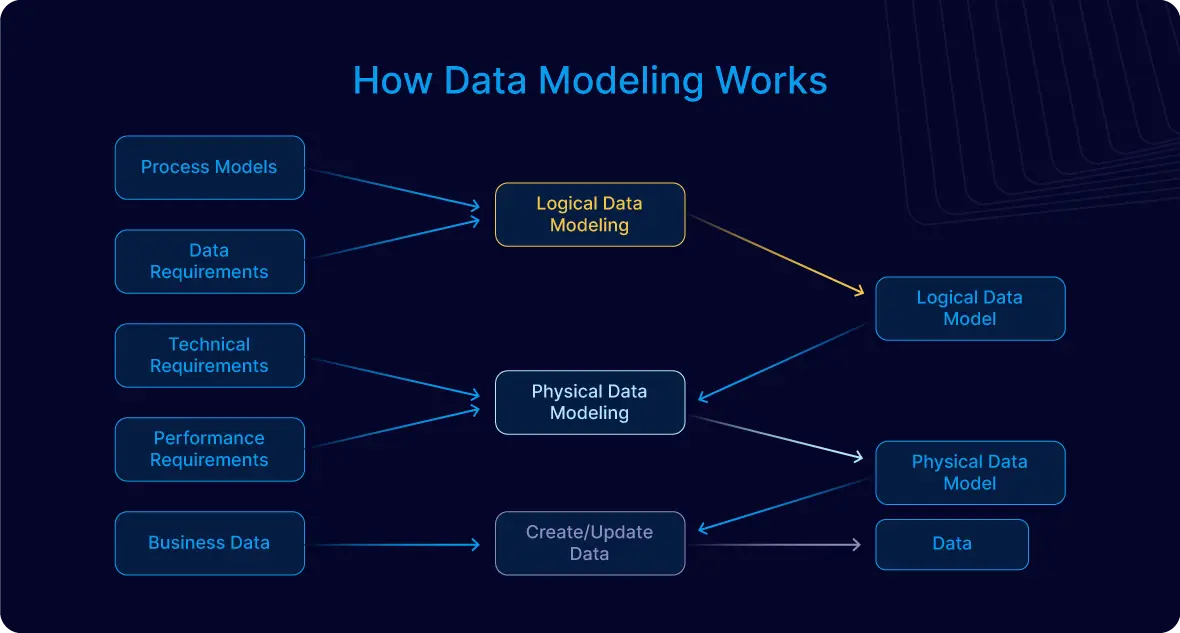Artificial intelligence (AI) uses information to make important choices in different industries. Just like a tall building needs a strong plan and base, successful AI requires good data models. While traditional business intelligence and reporting use cases allow some margin of error, hallucinating AI in customer experiences can be costly for a brand. So how do we create these models for complex algorithms and systems? Organizing, storing, and accessing data is important for AI. It affects how well AI programs and apps work. Incorporating AI into data modeling relies on fundamental techniques and principles that enhance the synergy between data and AI models.
These five key principles will show us how. Data modeling for AI involves making a structured framework that helps AI systems efficiently process, analyze, and understand data to make smart decisions:
The 5 Fundamentals
- Data Cleansing and Validation: Provide data accuracy and consistency by addressing errors, missing values, and inconsistencies. Techniques like outlier detection and imputation help make sure your data is reliable and ready for analysis.
- Feature Engineering: Craft the right features – the building blocks of your model – by selecting the most relevant and informative ones. Techniques like correlation analysis and feature importance scores guide this crucial step.
- Data Transformation: Prepare your data for analysis by handling scaling issues and addressing skewed distributions. Techniques like normalization and min-max scaling ensure all features contribute equally to model training. Striim’s intuitive platform streamlines data transformation processes, saving you time and resources.
- Model Explainability: Build models that not only give you an answer but also explain how they arrived at it. Techniques like LIME and SHAP shed light on the decision-making process, fostering trust and ethical considerations.
- Scalability and Performance Optimization: Design your model to handle growing datasets and evolving needs. Consider distributed computing frameworks and cloud solutions for efficient processing and future-proofing your AI project.
One excellent source for delving deeper into data modeling is the podcast episode by Joe Reis and Ben Rogojan. Data Modeling With Joe Reis – Understanding What Data Modeling Is And Where It’s Going
Key Principles in Action
- Data Quality: According to a study by Deloitte, following good ways to clean and check data can save money and make information more accurate. This, in turn, leads to enhanced model performance, unlocking the true potential of your AI investments. Additionally, addressing data biases and inconsistencies guarantees ethical considerations are embedded within your AI development process.
- Feature Selection: One advantage of concentrating on important features is that it enhances model efficiency. By using feature engineering tools, you can improve efficiency and accuracy by cutting unnecessary noise. Additionally, having fewer features results in better interpretability, making your AI models more transparent and reliable.
- Normalization: A research paper published by the University of Utrecht explains how normalization improves model convergence, leading to faster and more stable model training. This ultimately translates to reduced bias, as normalization prevents features with larger scales from dominating the learning process.
- Model Interpretability: Building trust with users is crucial for AI adoption. A survey by PwC found that 73% of respondents would be less likely to trust an AI system if they couldn’t understand how it makes decisions. Using methods like LIME and SHAP can help you create trust and transparency in your AI development, promoting ethical thinking and responsible AI practices.
- Scalability: As your AI ambitions grow, your data models need to keep pace. A scalable and flexible architecture provides your models can handle growing data volumes and adapt to evolving needs. This, combined with cloud-based and distributed technologies, future-proofs your AI project, guaranteeing it remains effective and efficient even as your data landscape expands.
Business Value
By following these principles and employing the capabilities, you tap into the full potential of AI efforts and achieve:
- Improved decision-making: Gain deeper insights from data-driven predictions, leading to informed business decisions that drive growth and competitive advantage across various domains.
- Enhanced operational efficiency: Use reliable AI models to save time and work more efficiently. These models can handle tasks, make procedures easier, and improve resource allocation. This frees up human resources to focus on more important activities.
- Increased customer satisfaction: Deliver personalized experiences and tailored offerings based on accurate AI-powered predictions, fostering deeper customer engagement and loyalty.
- Reduced risks and improved compliance: Promote ethical AI development and address potential biases by implementing responsible data modeling techniques, protecting your organization’s reputation, and following changing regulatory standards.
Striim: Your Partner in Effective Data Modeling
Striim’s platform provides the means for integrating and analyzing data in real-time, greatly improving the data modeling process when applying AI. Here are four instances where Striim’s solution can aid in the successful incorporation of AI in data modeling:
- Real-Time Data Integration and Streaming: Striim enables the ongoing collection of data from a diverse range of origins, such as databases, logs, message queues, and cloud platforms. This feature guarantees that the data used for AI modeling remains current, a critical element for applications that rely on real-time analytics or decision-making. By supplying fresh data, AI models can make more precise forecasts and choices based on the most recent information, improving their dependability and efficiency.
- Data Preprocessing and Transformation: Before creating models, data needs to be prepared by cleaning, transforming, or combining it. Striim provides real-time data processing to take care of these tasks as data flows into the system. This makes the modeling process faster and enhances model accuracy by providing that high-quality, properly formatted data is used in AI models.
- Scalability and Efficiency: AI and machine learning models need a scalable infrastructure for efficient data processing and analysis. Striim’s platform can handle large volumes of data in real-time, providing efficient and effective data modeling as data grows.
- Enhanced Decision Making with Real-Time Analytics: Striim’s real-time analytics can inform decision-making with immediate insights and AI integration for adjusting strategies, optimizing operations, and predicting future trends. This allows for a dynamic and responsive approach to data modeling with continuous updates and improvements based on real-time data and analytics.
With Striim’s real-time data integration, processing, and analysis capabilities, we’re basically giving AI a shot of espresso – making it faster, stronger, and more accurate than ever before. Say goodbye to slow and clunky data modeling, and hello to a sleek, efficient, and scalable AI-driven solution.
Ready to unlock the power of AI with effective data modeling?
Get a free demo of Striim today and experience the difference for yourself!























